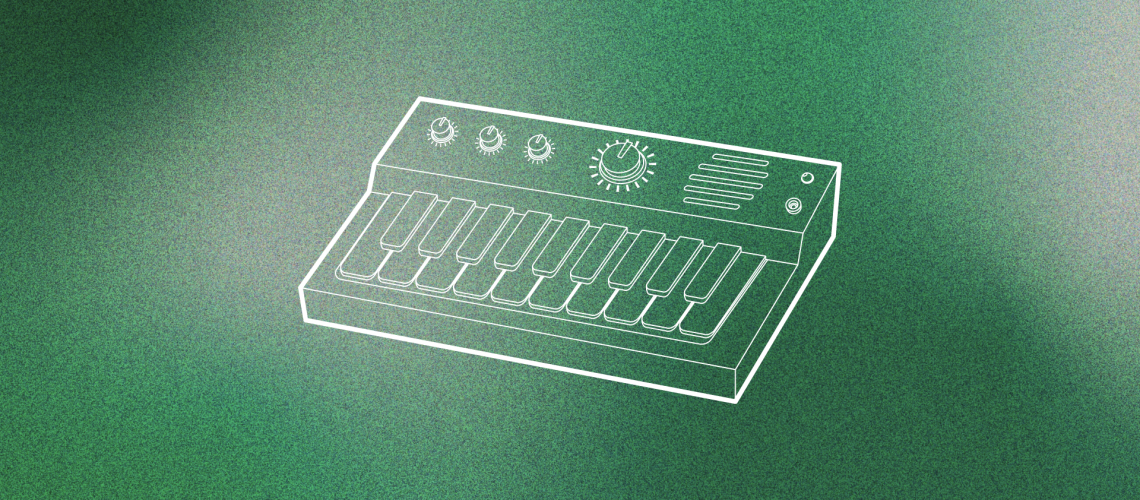Analog synths (or synthesizers) are the holy grail of any music producer. They give you that warm, rich tone that so many producers aim for.
But actual physical, hardware analog synths can often be pricey – not to mention the space each one takes.
Enter the world of VST analog synths: instrument plugins replicating analog gear.
No need to break your piggy bank or rent a bigger studio, everything now fits in your DAW while sounding (pretty much) the same!
In this guide, we’ll explore:
- the difference between analog and digital synths
- what sets VST analog synths apart
- the best options out there
- tips on getting the most out of each synth
Let’s get started! 👇
First Things First: What is an Analog Synth? 🤔
Before anything else, let’s cover what an analog synth actually is.
An analog synthesizer is a synthesizer that uses analog circuits and signals to generate sound.
Basically, you can think of an analog signal as a continuous signal representing some value (Volts, dBs, etc.). A digital signal on the other hand is an “approximation” of an analog signal. This is why digital signals are also referred to as a “sampled sequence” of the original signal:

Analog synths came to prominence in the 1920s and 1930s. Early synths would use a combination of computer components and lab equipment. They were often “modular”, meaning different electronic modules could be connected by cables:

Then in 1970 came the Minimoog, a revolution in the world of analog synths. Modular synths were complex to operate – imagine trying to recreate a preset with 30 cables in front of you. So Moog simplified the entire design:

With no more cables and an integrated keyboard, the Minimoog became a hit. Today, an original Minimoog can fetch close to US$10,000!
So What About VST Analog Synths? 🔌
With the advent of the Personal Computer, engineers started designing digital synths. These were synths living entirely in the digital realm, i.e. your computer. No more analog electronics, everything now lives “in the box”:

However, some felt that the rich sound of analog synths had been lost in the process.
Remember, analog synths are closer to a violin than a computer. They give you a sound based on electronic components interacting together. With digital synths, it’s all 1s and 0s.
So virtual analog synths came along. These were digital synths replicating the intricate functioning of a physical analog synth.
You could now have the best of both worlds: an (almost) analog sound living in your computer!
Over the years, manufacturers started making more and more emulations of analog synths. Today, there are hundreds of options on the market, from free to very (very) expensive.
It can be a whirlwind to navigate, but fear not! We are here to hold your hand and explore the best options out there. So let’s jump in!
Recommended: The 51 Best Free VST Plugins
Native Instruments Monark
Having talked about the Minimoog in our intro, it’s only right to kick things off with Monark. NI’s Monark is described as “delivering the sound of the king of analog monosynths”:

Many have described Monark as the best digital replica of the Minimoog. Monark is a monophonic synthesizer best suited for bass, leads, percussion, and effects.
Let’s go over its interface. Monark has 4 main sections:
- CONTROL: these are your main controls such as tuning, gliding, and noise amount
- OSCILLATORS: Monark provides you with 3 oscillators and a choice of 6 waveforms
- MIXER: controls the volume of each oscillator and the feedback level
- FILTER and AMP: this is where you access your ADSR envelope and filter
As you open Monark, this is the default sound you have:
Doesn’t get more analog and warm than that!
Monark comes with plenty of hundreds of presets ready to use, from classic basses to piercing leads:
Under the “B View”, you have access to your “Macro” controls such as type of legato and pitch bend curve:

One cool feature of Monark is the ability to completely distort your sounds with “Feedback” and “Noise”:
If you’re looking for one of the best emulations of the classic Minimoog, Monark is the one. Or if you’re simply looking for a warm, retro-sounding analog synth, Monark will keep you entertained for days.
Arturia KORG MS-20 V
The Korg MS-20 was originally released in 1978 and in production until 1983. It was re-introduced in 2013 in a reduced-sized form while keeping all of its original capabilities:

The Korg MS-20 uses subtractive synthesis (a topic we’ve covered in depth here). It also features a semi-modular interface allowing for re-routing of audio.
Similar to the Minimoog, the original Korg MS-20 is a monophonic synth. This means it is best suited for basslines, leads, and FX.
However, Arturia emulation provides 6-voice polyphony, making it a great option for pads too.
The Korg MS-20 is also known for its screaming filters, which the Arturia synth replicates to perfection:

From the interface, it’s quite clear this is not a beginner’s analog synth. But if you’re willing to get your hands dirty, the MS-20 will get you any sound you’re looking for:
Arturia Prophet-5 V
Looking for something a bit more approachable? Take a look at the Prophet-5 V:

The Prophet-5 V is modeled after the original Prophet-5 by Sequential. Manufactured in 1977, it was the first polyphonic synthesizer with programmable memory.
This meant you can save and store “presets”, instead of having to re-configure the entire synth each time.
Because of this (at the time) unique feature, it became widely adopted. It featured on Michael Jackson’s Thriller, Madonna’s Like a Virgin, the Bladerunner soundtrack by Vangelis, and much more.
Arturia’s analog synth recreation is possibly the closest you’ll get to the real deal. Although its parameters might seem limited (a common theme with analog synths), the Prophet-5 can recreate almost any sound:
The Prophet-5 features 2 oscillators with a choice of 3 waveforms. Arturia has also retrofitted an arpeggiator for easy arps and melodies:

Note that the Prophet-5, alongside the Korg MS-20, is part of the Arturia V9 Collection. The eye-watering anthology of synths comes at a hefty price but includes all the analog synths you’ll need for a lifetime. Thirty-three in total to be precise. This is where most of my daydreams are spent 😥
Buy the Arturia Prophet-5 V here (US$ 199) 👈
Get the Arturia V9 Collection here (US$ 599) 👈
TAL U-NO-LX
Moving on the something a bit more affordable is the U-NO-LX by TAL:

This analog synth is modeled after the popular Roland Juno 60. This analog synth was released in 1982 and featured the ability to save patches.
Producers often describe it as having a “fat, punchy” analog sound.
TAL’s recreation of the Juno 60 features all of the original functionalities, and then some:
- arpeggiator with different sync modes
- up to 12 voices
- 300 factory presets
- portamento and mono mode
Although more limited than other options on the market, the U-NO-LX is a great entry-level analog synth emulation. Its intuitive interface also makes it fast to master and get any sound you need.
u-He Diva
Diva by u-He stands for “Dinosaur Impersonating Virtual Analogue”. Quite an original name if you ask me, but there’s truth to it. The Diva is indeed a dinosaur of a synth:

Unlike the other synths we’ve covered here, the Diva isn’t modeled after one specific analog synth. Rather, it draws inspiration from decades of hardware synth innovations. Some of its features include:
- 5 oscillator models
- 5 filter models
- 2 stereo effects slots with a choice of chorus, phaser, reverb and more
- customizable layout
Diva has the spirit of analog captured in a modern synth. The only “downside” is that it is extremely CPU-intensive. But that’s a small price to pay for an authentic-sounding analog synth.
DiscoDSP OB-Xd
The OB-Xd is modeled after the Oberheim OB-X:

This synth was launched in 1979 to compete with the Prophet-9. It was an analog synth using subtractive synthesis with up to 8 voice polyphony. Like the Prophet-9, it offered the possibility to store away presets.
The OB-Xd is a recreation of that analog synth, featuring some additional features such as micro random detuning. This gives the synth a richer, fuller sound:

One (very) cool feature of the OB-Xd is that the demo version is fully functional. As per their website, “the free trial version of OB-Xd has no functional limitations”, but “does not allow commercial use”.
Synapse Audio The Legend
Another emulation of the Minimoog, the Legend deserves a place on this list:

The Legend is another synth faithfully emulating the original without mentioning it. In addition to the classic, warm Minimoog feel, The Legend provides:
- 4 voice polyphony
- 2 built-in effects (reverb and delay)
- over 530 patches included
- 2 “Revision Models”: Early and Late
According to the maker, physical considerations such as “temperature change” were integrated. This is probably as close as you’ll get to owning an actual Minimoog!
Arturia Pigments
Closing of this guide with a synth that is not strictly speaking analog: Pigments.

Without even getting into functionalities, Pigments already gets the “sleekest design” prize.
Described as a “Polychrome software synthesizer”, Pigments is aimed at making sound design as simple as possible.
What truly makes Pigments unique is its combination of different synthesis methods:
- additive synthesis with its harmonic engine
- wavetable synthesis (similar to how Serum works)
- virtual analog synthesis featuring 3 oscillators and 5 waveforms
- sampling thanks to the Sampler engine, allowing you to import, warp and distort any sample of your choice
- a utility engine allowing you to add 2 layers of noise samples and an additional oscillator
You can combine 2 of the engines (additive, wavetable, analog, or sample) and add the utility engine on top.
Basically, every sound imaginable can be recreated. I know that every synth claims that, but in the case of Pigments, it’s actually true:
Similarly to the Vital synth, Pigments uses color coding to intuitively navigate the interface. And similarly to Vital, modulating parameters is as simple as drag-and-dropping. Wait, maybe Vital actually took inspiration from Pigments…
Note: if there’s a synth I’m saving up for, it’s this one…
That’s a Wrap! 🙏
That’s it for this guide! I hope you discovered some new synths and were inspired to create amazing sounds! But please don’t go into debt because of me 😁
Did I miss out on anything? Let me know over at [email protected]




